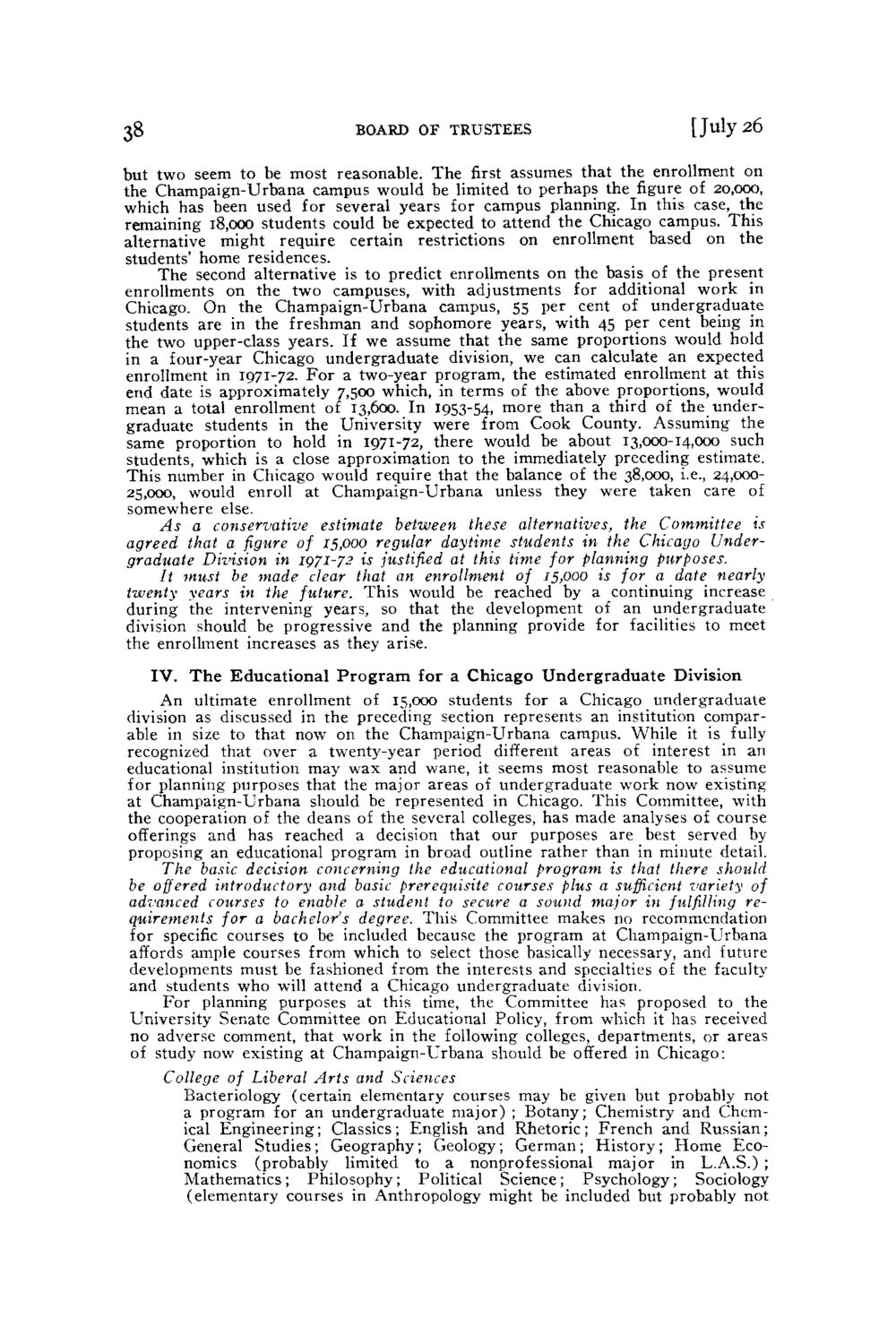| |
| |
Caption: Board of Trustees Minutes - 1956
This is a reduced-resolution page image for fast online browsing.

EXTRACTED TEXT FROM PAGE:
38 BOARD OF TRUSTEES [July 26 but two seem to be most reasonable. The first assumes that the enrollment on the Champaign-Urbana campus would be limited to perhaps the figure of 20,000, which has been used for several years for campus planning. In this case, the remaining 18,000 students could be expected to attend the Chicago campus. This alternative might require certain restrictions on enrollment based on the students' home residences. The second alternative is to predict enrollments on the basis of the present enrollments on the two campuses, with adjustments for additional work in Chicago. On the Champaign-Urbana campus, 55 per cent of undergraduate students are in the freshman and sophomore years, with 45 per cent being in the two upper-class years. If we assume that the same proportions would hold in a four-year Chicago undergraduate division, we can calculate an expected enrollment in 1971-72. F o r a two-year program, the estimated enrollment at this end date is approximately 7,500 which, in terms of the above proportions, would mean a total enrollment of 13,600. In 1953-54, more than a third of the undergraduate students in the University were from Cook County. Assuming the same proportion to hold in 1971-72, there would be about 13,000-14,000 such students, which is a close approximation to the immediately preceding estimate. This number in Chicago would require that the balance of the 38,000, i.e., 24,00025,000, would enroll at Champaign-Urbana unless they were taken care of somewhere else. As a conservative estimate between these alternatives, the Committee is agreed that a figure of 15,000 regular daytime students in the Chicago Undergraduate Dh'ision in igyi-y3 is justified at this time for planning purposes. It must be made clear that an enrollment of 15,000 is for a date nearly twenty years in the future. This would be reached by a continuing increase during the intervening years, so that the development of an undergraduate division should be progressive and the planning provide for facilities to meet the enrollment increases as they arise. I V . T h e E d u c a t i o n a l P r o g r a m for a Chicago U n d e r g r a d u a t e Division An ultimate enrollment of 15,000 students for a Chicago undergraduate division as discussed in the preceding section represents an institution comparable in size to that now on the Champaign-Urbana campus. While it is fully recognized that over a twenty-year period different areas of interest in an educational institution may wax and wane, it seems most reasonable to assume for planning purposes that the major areas of undergraduate work now existing at Champaign-Urbana should be represented in Chicago. This Committee, with the cooperation of the deans of the several colleges, has made analyses of course offerings and has reached a decision that our purposes are best served by proposing an educational program in broad outline rather than in minute detail. The basic decision concerning the educational program is that there should be offered introductory and basic prerequisite courses plus a sufficient variety of advanced courses to enable a student to secure a sound major in fulfilling requirements for a bachelor's degree. This Committee makes no recommendation for specific courses to be included because the program at Champaign-Urbana affords ample courses from which to select those basically necessary, and future developments must be fashioned from the interests and specialties of the faculty and students who will attend a Chicago undergraduate division. For planning purposes at this time, the Committee has proposed to the University Senate Committee on Educational Policy, from which it has received no adverse comment, that work in the following colleges, departments, or areas of study now existing at Champaign-Urbana should be offered in Chicago: College of Liberal Arts and Sciences Bacteriology (certain elementary courses may be given but probably not a program for an undergraduate major) ; Botany; Chemistry and Chemical Engineering; Classics; English and Rhetoric; French and Russian; General Studies; Geography; Geology; German; History; Home Economics (probably limited to a nonprofessional major in L.A.S.) ; Mathematics; Philosophy; Political Science; Psychology; Sociology (elementary courses in Anthropology might be included but probably not
| |